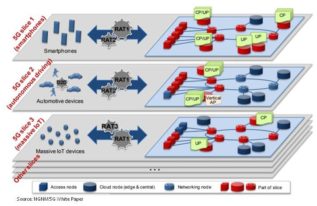Network Slicing is a network architecture technique that enables extra flexibility and scalability for 5G networks. It can be utilized by businesses to help digitize and mobilize their operations, and expand or improve their current business processes. Network Slicing may use common hardware and common architecture, but allows operation of different services over the same fixed and mobile 5G platforms. In that way, the Network Operator can guarantee a certain Service Level Agreement (SLA) with each customer for each specific service.
What is a network slice?
5G services may have totally different requirements regarding speed, latency, reliability, security, etc. These services can be differentiated by forming virtual routes, also known as network slices, per specific service, according to each service needs.
In other words, wherever Network Slicing is applied, the services can be distributed over the same network but with each slice optimized for a specific use case.
Network Slicing can provide a more flexible approach for 5G service provisioning since it becomes relatively easy to dynamically add or remove a slice, as all resources can be administrated by the NMS platform.
Network Slicing in 5G RAN
Network slicing architecture relies on the principle that traffic for different slices is handled by different PDU sessions. The network can realize the different network slices by scheduling and providing different L1/L2/L3 configurations.
The 5G network should be able to select the RAN part of the network slice and match it to the corresponding CN entity. The system should handle resource management between slices, by monitoring slice availability and providing slice granularity and slice isolation.
Furthermore, it should be possible to validate the rights to access a network slice and associate a user device with multiple network slices at the same time. For example, a moving vehicle may simultaneously require a high bandwidth slice for infotainment and an ultra-reliable slice for telemetry and assisted driving.
Network Slicing Standardization activities
There are various standardization entities currently working on Network Slicing research and specifications. Most of the work is carried out by telecom standardization bodies such as IEEE, NGMN, the 3rd Generation Partnership Project (3GPP), and the 5th Generation Infrastructure Public-Private Partnership (5G-PPP). 3GPPP and 5GPPP with current work on 5G MONARCH, 5G NORMA, 5GEx, and SLICENET projects, have been collaborating with ITU-T, ITU-R and IETF to define the specifications and provide a reasonable roadmap for Network Slicing features and functionalities.
There are also various Academic, Commercial, Governmental or public/private bodies, together with telecom vendors and leading Operators that are working on PoCs, demos and live environment trials to provide the appropriate proof on Network Slicing operation and the benefits of this technology on existing 4G networks and the first 5G deployment cases.
Network Slicing implementation
In a 5G network, the gNodeB should be able to handle URLLC, eMBB and IoT services. Network slicing can, therefore, be implemented to provide the appropriate service differentiation and required provisioning.
Shared Resources: Several services may share a common radio resource, as in the NORMA/MONARCH approach, also used in current trials. The services are differentiated by APNs and served by “slice specific” packet gateways over a shared transport network.
Slice specific packet gateways can be reached by standard destination-based routing. To serve the particular needs of the different slices on transport, the traffic can be identified based on source or destination IPs and treated according to the service needs, via specific route policies.
Dedicated Resources: Another approach is to have a dedicated radio resource and a dedicated CN per network slice. This is partly implemented today for NB-IoT in existing 4G networks. A shared transport network can also be used with standard destination-based routing, again based on source and destination IP addresses for traffic identification and handling.
VPNs can also be used in the IP backhaul and IP backbone network to allow logical segregation on the transport. However, the advantage of such an implementation is questionable since the transport is still shared.
Some radio vendors are promoting Flexible Ethernet (FlexE) to reserve certain resources assigned to a specific network slice. FlexE implementation could be reasonable if the Telecom Operator is going to offer a service, where the customer can book or manage their own slice, e.g., via a Web interface, having sole responsibility. In this case, if the Operator wants to guarantee a specific SLA at the transport level, hard slicing on transport layer might be necessary.
Drawbacks and Benefits
According to some vendors, FlexE is the only way to guarantee specific SLAs, however, any trunking gain of modern Ethernet-based transport networks is lost, which could make this approach not cost effective.
As logical segregation into VPNs causes additional effort without a real benefit, the 5G Telecom Operators could use a shared transport network without slice specific VPNs regardless of network slicing on the radio or CN level.
The slice specific needs can be supported by appropriate measures like MPLS traffic engineering to ensure latency, jitter, bandwidth, and reliability. Traffic can again be distinguished via source & destination IPs. The alternative approach using MPLS segment-routing with dedicated traffic engineered paths managed by an SDN controller could, therefore, be a preferred choice.
Network Slicing has obvious benefits that most 5G Mobile Operators are starting to explore. The final decision on which specific Network Slicing architecture is going to be implemented will be made upon existing network architecture, the ease of network adaptability and the Operator’s specific needs.













